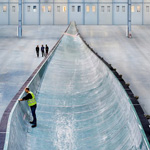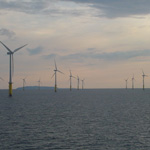
Siemens new 75m turbine. Copyright Siemens
Two new technological developments in the global wind power industry have been garnering media interest recently as the emissions-free generating sector continues to increase its world-wide installed capacity year after year after year.
Siemens announced earlier in August that it had built, at 75 metres, the world’s largest rotor blade for wind turbines.
By way of comparison, and to understand just how long the new Siemens blade is, those who attended EWEA’s Annual Event in Copenhagen in April 2012 may remember that massive LM Wind Power 73.5-metre blade displayed outside the Bella Center.

North Hoyle offshore wind farm
While this blog frequently focusses on wind power reporting in national-level newspapers, the regional-level or local newspaper does not get as much attention as it perhaps merits.
Last month I was in North Wales – a coastline which is home to the UK’s first large scale offshore wind farm called North Hoyle. It currently has one other operating offshore wind farm – Rhyl Flats, and a massive development is underway further out to sea at Gwynt y Môr offshore wind farm which, when completed in 2013, is set to provide electricity to cover nearly one-third of homes in Wales.
There is, of course, local opposition. On this particular stretch of coastline the opposition group is called Save Our Scenery – slightly ironic given that the new offshore farm is 18 km offshore and will be frequently out of vision thanks to the often dense banks of Welsh cloud.

EWEA Research Officer Angeliki Koulouri
A new study, published by the Bavarian Environment Agency in Germany, has found that wind turbines do not generate infrasound at a level that would damage human health, backing-up previous studies with similar conclusions.
Wind energy structures generate infrasound which is far below normal human hearing and perception, which is why it cannot cause any damage to people, the study – ‘Wind turbines: does infrasound affect health?’ concludes. Angeliki Koulouri, Research Officer at EWEA, said: “so far, research indicated that infrasound and low frequency sounds from modern wind turbines are well below the level where known health effects occur.”
 Today’s turbines can be mind-bogglingly big, but big is not necessarily better. Mike Woebbeking, Vice President of GL group and chair of a session at EWEA 2012 in Copenhagen on 16 April that delves into turbine size, tells the EWEA blog that size isn’t everything…
Today’s turbines can be mind-bogglingly big, but big is not necessarily better. Mike Woebbeking, Vice President of GL group and chair of a session at EWEA 2012 in Copenhagen on 16 April that delves into turbine size, tells the EWEA blog that size isn’t everything…
How has the average turbine size changed over the last decade?
Ten years ago the average size was around 1.5 MW, today it is close to 3 MW. Thus the average size of onshore wind turbines more or less doubled. For offshore wind this is more difficult to say. A decade ago there were only very few turbines installed offshore. The average size could be assumed to be around 1.5 MW. Today the average offshore turbine size is below 5 MW, however 7 MW turbines and bigger are under development. The average size of offshore turbines has roughly tripled within a decade.
 When I tell people I work in wind energy, the reaction is generally one of approval. Wind energy is green, it helps the planet. People approve.
When I tell people I work in wind energy, the reaction is generally one of approval. Wind energy is green, it helps the planet. People approve.
Despite this, most developers of wind farms will have had to deal at one time or other with ‘NIMBYism’ which can cause delays to projects. And any delay to a wind farm project costs time and money to a developer – and delays the environmental and economic benefits from the wind farm. Wind Directions investigates the issue of public acceptance and how it can be managed.








 Comments
Comments



